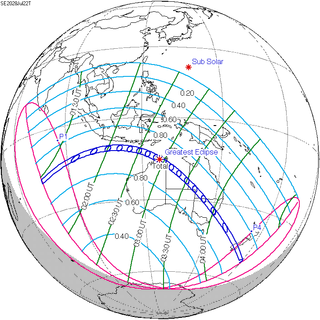| Solar eclipse of July 22, 2028 | |
|---|---|
| Type of eclipse | |
| Nature | Total |
| Gamma | −0.6056 |
| Magnitude | 1.056 |
| Maximum eclipse | |
| Duration | 310 s (5 min 10 s) |
| Coordinates | 15°36′S 126°42′E / 15.6°S 126.7°E |
| Max. width of band | 230 km (140 mi) |
| Times (UTC) | |
| Greatest eclipse | 2:56:40 |
| References | |
| Saros | 146 (28 of 76) |
| Catalog # (SE5000) | 9570 |

A total solar eclipse will occur at the Moon's descending node of orbit on Saturday, 22 July 2028,[1] with a magnitude of 1.056. A solar eclipse occurs when the Moon passes between Earth and the Sun, thereby totally or partly obscuring the image of the Sun for a viewer on Earth. A total solar eclipse occurs when the Moon's apparent diameter is larger than the Sun's, blocking all direct sunlight, turning day into darkness. Totality occurs in a narrow path across Earth's surface, with the partial solar eclipse visible over a surrounding region thousands of kilometres wide. Occurring about 1.8 days before perigee (on 23 July 2028, at 23:20 UTC), the Moon's apparent diameter will be larger.[2]
The central line of the path of the eclipse will cross the Australian continent from the Kimberley region in the north-west and continue in a south-easterly direction through Western Australia, the Northern Territory, south-west Queensland and New South Wales, close to the towns of Wyndham, Kununurra, Tennant Creek, Birdsville, Bourke and Dubbo, and continuing on through the centre of Sydney, where the eclipse will have a duration of over three minutes. It will also cross Queenstown and Dunedin, New Zealand. Totality will also be viewable from two of Australia's external territories: Christmas Island and the Cocos (Keeling) Islands. A partial eclipse will be visible for parts of Southeast Asia, Australia, and Oceania.[citation needed]
This is the first time Sydney will experience a total solar eclipse since 26 March 1857 and will be the last until 3 June 2858.[3]
- ^ "July 22, 2028 Total Solar Eclipse". timeanddate. Retrieved 13 August 2024.
- ^ "Moon Distances for London, United Kingdom, England". timeanddate. Retrieved 13 August 2024.
- ^ Espenak, Fred. "Major Solar Eclipses visible from Sydney, Australia". NASA Goddard Space Flight Center.
